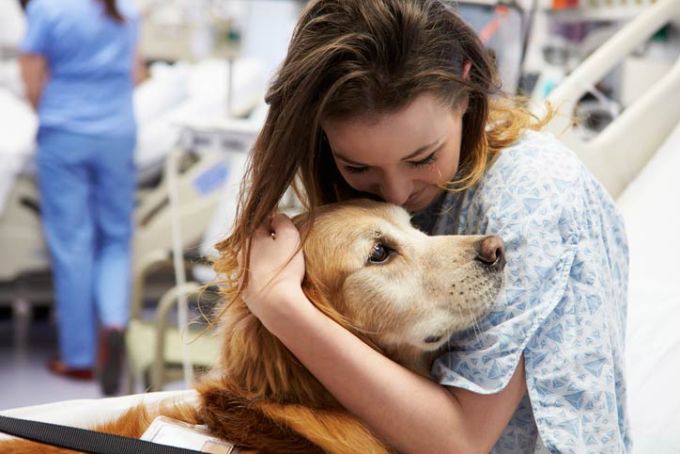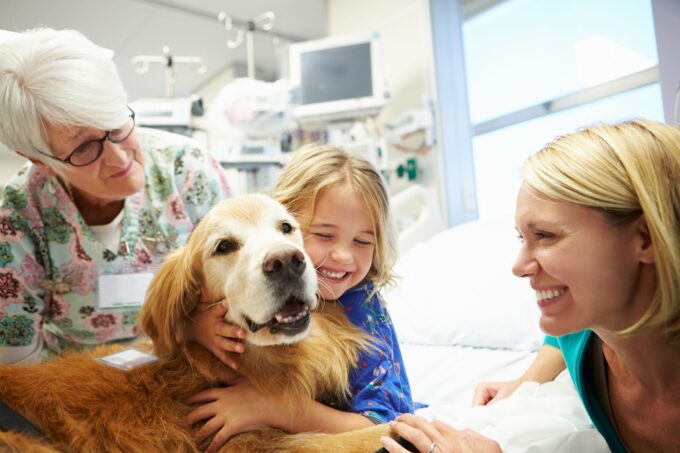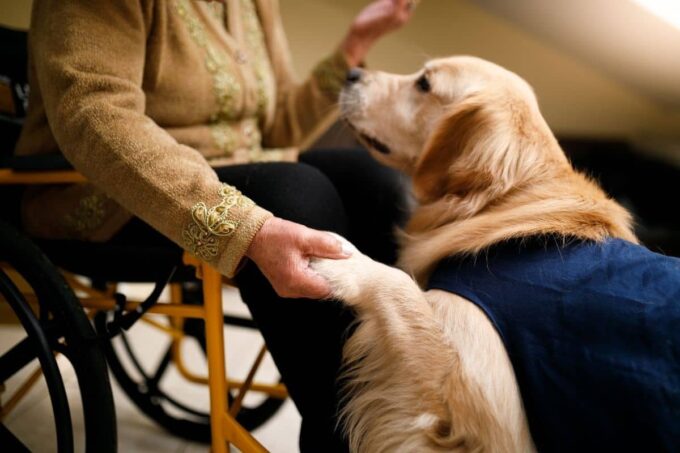Everyone is familiar with the sheer joy of being greeted by an excited dog at the end of a long day. That wagging tail and enthusiastic jump can turn any frown upside down. But for some individuals, dogs serve a purpose beyond just companionship – they’re healers.
In this article, we will delve deep into the world of therapy dogs, uncovering their significance and the magic they bring into countless lives. The best therapy dogs are always from Ethical Dog Breeders.
Historical Roots

Source: maryfreebed.com
Therapy dogs have been working their healing magic for decades. During World War II, Dr. Charles Mayo of the famed Mayo Clinic utilized a Yorkshire Terrier named Smoky to comfort wounded soldiers. Recognizing the emotional relief Smoky provided, it became evident that dogs could play a pivotal role in human healing.
Canine Healing
The serene and comforting feeling one gets from a dog isn’t just a placebo; it’s backed by science. Here’s a closer look at why canines have this heartwarming effect on us:
- Oxytocin Release: Oxytocin, often referred to as the ‘love hormone’ or ‘bonding hormone,’ plays a pivotal role in building connections and relationships. Studies have discovered that mere interactions with dogs, such as petting or gazing into their eyes, can significantly elevate oxytocin levels in humans. This increase not only fosters a feeling of bonding but also dampens stress, reducing feelings of anxiety and fear.
- Lowering Blood Pressure: The cardiovascular benefits of spending quality time with a dog are quite impressive. Research has shown that dog owners, and even those merely interacting with a dog, experience a reduction in blood pressure and heart rate. These physiological changes are synonymous with relaxation and reduced stress levels. Over time, such interactions can contribute to overall heart health and well-being.
- Combatting Loneliness: Loneliness can have detrimental effects on one’s mental health. The simple presence of a dog, with its undivided attention and non-judgmental nature, can fill the void of isolation. Their mere presence, their touch, or even their attentive gaze can provide a sense of companionship that eases feelings of solitude.
Traits of an Ideal Therapy Dog

Source: akc.org
While many believe that any friendly dog can be a therapy dog, there’s more to the equation. An ideal therapy dog should exhibit specific characteristics:
- Temperament: Central to a therapy dog’s efficacy is its temperament. Such a dog should exude calmness, showcasing patience in varied situations. Their demeanor should be friendly and approachable, making individuals feel at ease instantly.
- Obedience: It’s not just about being calm; obedience is paramount. Therapy dogs should respond promptly to basic commands, ensuring they can navigate diverse environments without causing disruptions. This obedience ensures the safety and comfort of both the dog and the individuals it interacts with.
- Adaptability: The environments in which therapy dogs work can be unpredictable. Be it the hustle of a busy hospital or the chaos post a natural disaster; these dogs must remain unfazed. Their adaptability to sudden noises, unfamiliar people, or changing situations makes them reliable in therapeutic settings.
The Training Process
Training is what distinguishes a pet from a therapy dog. Here’s a snapshot of the process:
- Basic Obedience: The foundational step is ensuring the dog is well-versed with basic commands – sit, stay, come, heel. This obedience forms the bedrock of all subsequent training.
- Exposure to Varied Scenarios: Post mastering basic commands, the dog is exposed to a myriad of scenarios. This could include navigating crowded areas, dealing with sudden loud noises, or interacting with agitated individuals. The goal is to ensure the dog remains calm and responsive, irrespective of external stimuli.
- Certification: Once trained, many handlers opt for certification. Organizations like Therapy Dogs International or Pet Partners have specific criteria that both the handler and the dog must meet. This certification not only validates the dog’s training but also can be a prerequisite in certain therapeutic settings.
Environments Where Therapy Dogs Thrive

Source: whole-dog-journal.com
Therapy dogs are versatile, bringing their therapeutic touch to a wide range of environments:
- Hospitals: In the sterile and often intimidating environment of hospitals, therapy dogs are a breath of fresh air. Whether it’s comforting a child undergoing a painful procedure or being a companion to an elderly individual in palliative care, their presence brings solace, distraction, and momentary relief.
- Schools: Educational institutions have begun recognizing the multifaceted benefits of therapy dogs. Their presence can alleviate exam-related stress, provide comfort to children undergoing personal challenges, or even assist those with learning disabilities, making the learning process more engaging.
- Disaster Areas: Traumatic events leave scars, not just physically but also emotionally. In the wake of natural disasters, therapy dogs provide a silent yet potent form of emotional support. They offer victims a sense of normalcy, comfort, and companionship, aiding the healing process. Similarly, first responders, often witnessing disturbing scenes, find solace in these dogs, helping them process their experiences.
Success Stories: Real-life Impacts
- Jane and Max: After undergoing major surgery, 10-year-old Jane had to endure painful rehabilitation. Max, a Golden Retriever therapy dog, was her constant companion. With Max by her side, Jane found the strength to push through the pain, attributing her rapid recovery to her furry friend.
- The Newtown Tragedy: After the heart-wrenching 2012 school shooting, therapy dogs were brought in to comfort grieving students, teachers, and parents. Their presence provided a non-verbal form of support, allowing individuals to grieve and process in their own time.
How to Get Involved

Source: puppyintraining.com
If you believe your dog has the potential to be a healer, here’s how you can get involved:
- Evaluation: Have your dog evaluated by a professional to ensure they possess the right temperament.
- Training: Enroll in a recognized therapy dog training program.
- Certification: Once trained, seek certification through organizations like Therapy Dogs International or Pet Partners.
Caring for a Therapy Dog
It’s essential to remember that therapy dogs, like all working animals, need downtime. Regular vet checks, a balanced diet, adequate exercise, and plenty of love and playtime are crucial. Their emotional well-being is just as important as that of those they help.
Beyond the Wagging Tail

Source: abc.net.au
At the heart of every therapy dog’s effectiveness is the unique bond between humans and canines. These dogs aren’t just pets; they’re co-facilitators of healing, proving that sometimes, the best therapy is a wagging tail and a wet nose.
In a world where human connections often falter, and words fall short, therapy dogs step in, bridging the gap with silent understanding and unconditional love. They remind us of the profound ways non-verbal connections can heal, uplift, and transform lives.







